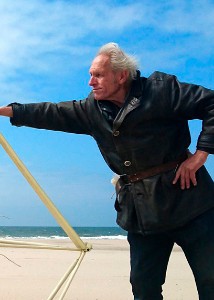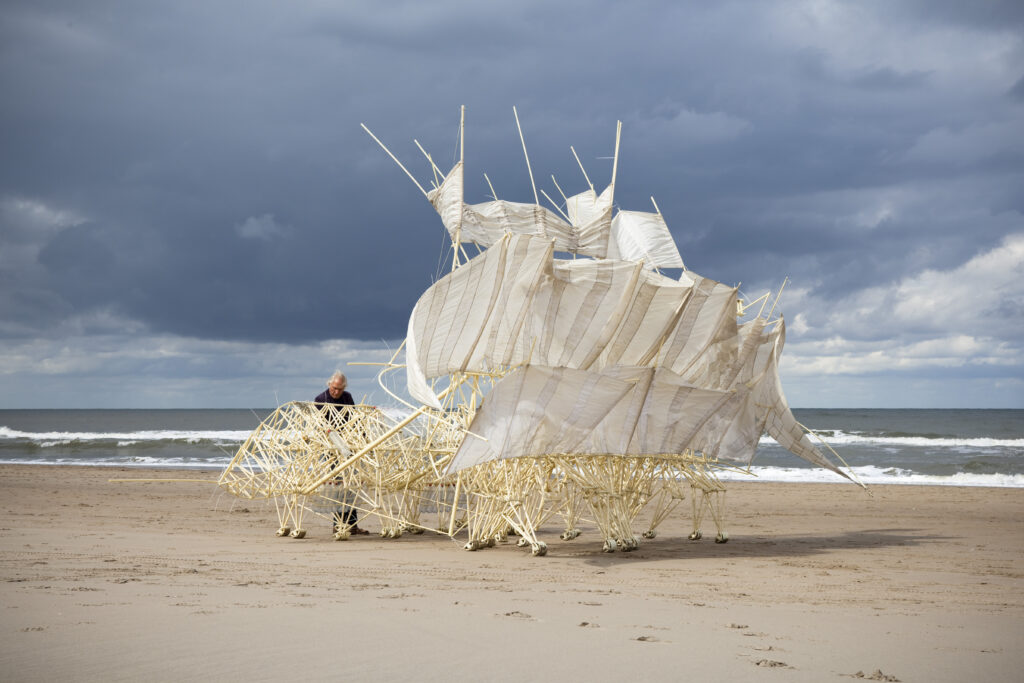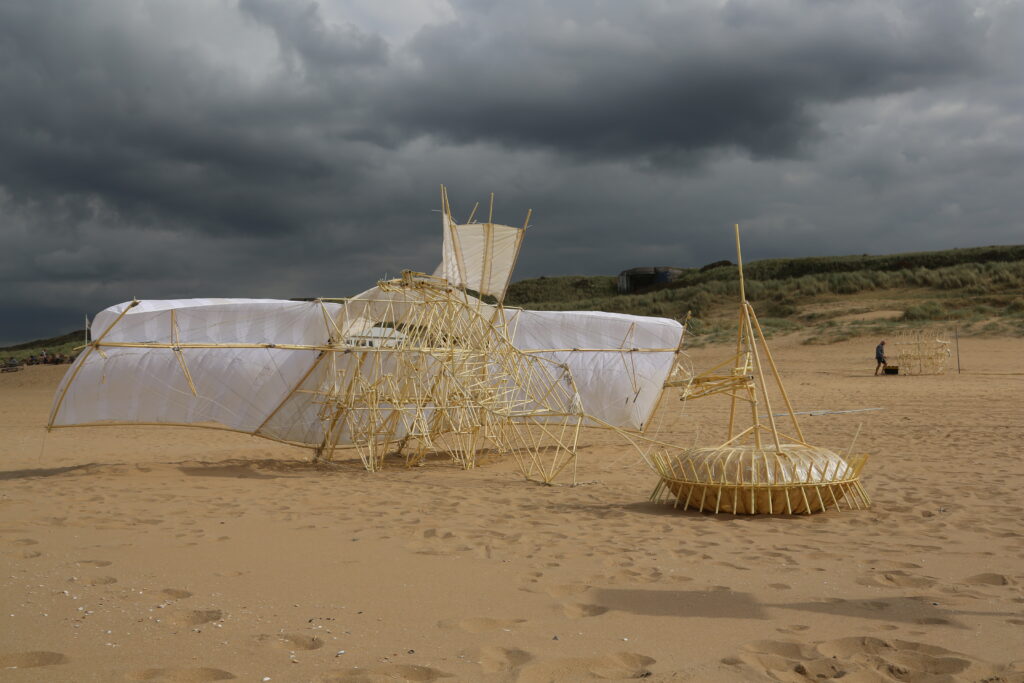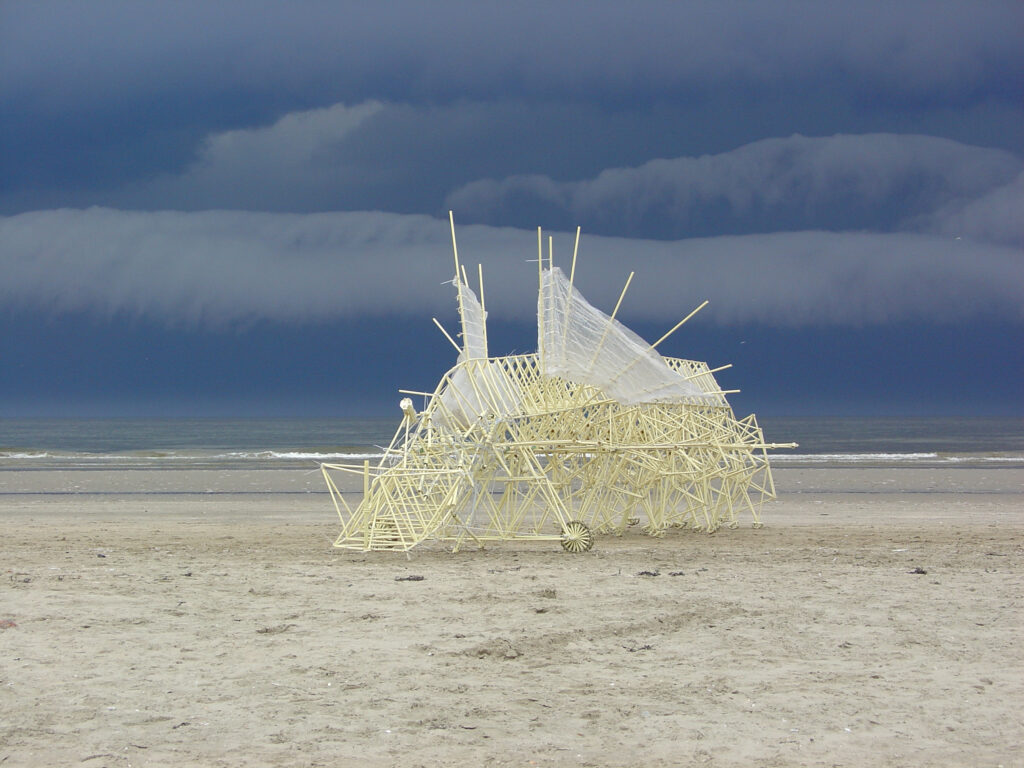Theo Jansen
ARTIST
Theo Jansen (Scheveningen, b. 1948)
Kinetic Sculptures

FEBRUARY 2022
The Beauty of Machines
Interview with Theo Jansen
BY REGINA DE CON COSSÍO
Photographs Courtesy of the Artist
Regina De Con Cossío: In recent years, many artists have approached science to build projects. What do you think distinguishes an art object made from science from a purely scientific object?
Theo Jansen: In my view, the distinction between art and science is very thin. Many scientists are more artists than they want to know. I think art is freer than science. You can play more. Scientists are usually tied to an institution and tied to agendas. The great privilege of the artist is that he can play without being held accountable.
RDCC: The concept of aesthetics has undergone several transformations. For classical or traditional art, aesthetics is synonymous with beauty. But since modernity and, partly inspired by contemporary art, it is not necessarily something beautiful or that causes a pleasure of the senses. Many artists see the aesthetic as a social and artistic construct where the shapes represent a feeling or an emotion in innovative ways. What is aesthetic to you?
TJ: That something is logical and that it is right is for me a form of aesthetics. You can also find it in mathematics. Especially when mathematics becomes visible as a mirror image. We have become so used to mirroring images that we no longer find it special and we do not dwell on it. It is amazing that there is a copy of the world behind the glass. It’s forbidden area. As soon as you want to move your finger to the mirror image world, a copy of that finger will come and it will stop. And it presses against your finger with exactly the same force, so you can’t get in. I think that logic is aesthetically beautiful.




RDCC: Your beings are born, evolve and disappear. They can be related in many ways to the process of a living being, but they have no organs or fluids at all: they lack blood, tears or sweat. These beings are a kind of model and, as we know, models serve to ask questions about the world. What is the question you want to ask your Strandbeest?
TJ: The Strandbeests are undergoing an evolution. My ideas are kind of mutations and most mutations don’t work. But sometimes something unexpected happens that allows them to take a step forward in their development. What the Strandbeests wonder and what I wonder is: how is it all possible? How can we exist? How did I get into my body? We marvel at our existence. A lot of people do that, but I never got over it. And neither do the Strandbeests.
RDCC: When a human or pet dies, their bodies rot and decompose. They disappear. Rituals are performed around them: people (and many pets too) have spaces where their relatives and close people visit them, talk to them and make complex memories to feel their presence. What happens to your Strandbeest in that sense?
TJ: Strandbeests don’t disappear, they go to the boneyard. These skeletons, or remains, represent a certain stage in evolution. The whole range of skeletons tells a story. A fairy tale perhaps, an invention of the artist, but it is true. It tells a story with strong roots in reality. It is a mirror image of our existence.
RDCC: Social anthropologist Mary Douglas explains that when thinking about dirt, it’s important to discuss the nexus “between order and disorder, being and non-being, form and formless, life and death.” How do you come up with these concepts when building the Strandbeest? What fate awaits them in a world grappling with climatic problems and whose survival is at stake on planet Earth in the coming decades?
TJ: It always surprises me that many people associate the Strandbeests with the climate crisis. Perhaps this thought arises because the beach animals get their energy from the wind and do not have to eat. I also regularly get comments along the lines of the Strandbeests being the last survivors on Earth. What I hope is that the Strandbeests can stimulate optimism. The optimism that is not based on a bicycle but on a feeling within ourselves. We need that optimism to face climate change.
RDCC: In the first part of this interview I asked you about concepts such as aesthetics, art or the role of the artist. But you artificial beings also marvel at man. I want to ask you a question that director Stanley Kubrick said guided much of his filmography: What makes us human, what distinguishes a human from a machine?
TJ: Yes, that’s a good question. Looking at you other people, I wouldn’t be able to distinguish. We are very complex machines. Our chemistry is based on (hereditary) tendencies or very complex reactions to sensory perceptions. Harari describes it beautifully in Homo Deus. He says we have no soul. You may not have a soul, but I’m sure I do. I think therefore I am. The question that always haunts me: why did my soul end up in this body.
La Belleza de las Máquinas
Entrevista con Theo Jansen
RDCC: En años recientes, muchos artistas se han acercado a la ciencia para construir objetos. Desde tu punto de vista, ¿que distingue a un objeto artístico hecho con base en la ciencia de un objeto puramente científico?
Theo Jansen: Desde mi punto de vista, la distinción entre arte y ciencia es muy delgada. Muchos científicos son más artistas de lo que quieren saber. Creo que el arte es más libre que la ciencia. Puedes jugar más. Los científicos suelen estar atados a una institución y atados a agendas. El gran privilegio de los artistas es que pueden jugar sin tener que rendir cuentas
RDCC: El concepto de estética ha sufrido varias transformaciones. Para el arte tradicional o clásico, la estética es sinónimo de belleza, sin embargo, desde la modernidad, motivada en parte por el arte contemporáneo, no es necesariamente lo bello lo que causa un disfrute en los sentidos. Muchos artistas conciben la estética como un constructo social y artístico en donde la forma representa un sentimiento o una emoción de manera innovadora. ¿Qué es para ti la estética?
TJ: Que algo sea lógico y que sea correcto es para mí una forma de estética. También puedes encontrarlo en matemáticas. Especialmente cuando las matemáticas se vuelven visibles como una imagen reflejo. Nos hemos acostumbrado tanto a reflejar imágenes que ya no lo encontramos especial y no nos detenemos en ellas. Es increíble que haya una copia del mundo detrás del cristal. Es una zona prohibida. Tan pronto como quieras mover tu dedo al mundo del reflejo de la imágen, aparecerá una copia de ese dedo y se detendrá. Y presiona contra tu dedo exactamente con la misma fuerza, por lo que no puedes entrar. Creo que la lógica es estéticamente hermosa.
RDCC: Tus criaturas nacen, evolucionan y desaparecen. Ellas podrían asemejarse de muchas formas a los procesos de los seres vivos, pero ellas no tienen órganos o fluidos: carecen de sangre, lágrimas o sudor. Estas criaturas son una especie de modelo y, como bien sabemos, los modelos sirven para hacernos preguntas acerca del mundo. ¿Cuál es la pregunta que tu Stranbeest quiere hacer?
TJ: Los Strandbeests están experimentando una evolución. Mis ideas son una especie de mutaciones y la mayoría de las mutaciones no funcionan. Pero a veces sucede algo inesperado que les permite dar un paso adelante en su desarrollo. Lo que se preguntan los Strandbeests y lo que yo me pregunto es: ¿cómo todo es posible? ¿Cómo podemos existir? ¿Cómo entré en mi cuerpo? Nos maravillamos de nuestra existencia. Mucha gente hace eso, pero yo nunca lo superé. Y tampoco los Strandbeests.
RDCC: Cuando un humano o un animal doméstico muere, sus cuerpos se pudren y se descomponen. Desaparecen. En torno a ellos se realizan rituales: los humanos (y muchas mascotas también) tienen espacios en donde sus familiares y personas cercanas los visitan, hablan con ellos y hacen recuerdos complejos para sentir su presencia. ¿Qué pasa en este sentido con tu Strandbeest?
TJ: Los Strandbeests no desaparecen, van al cementerio. Estos esqueletos, o restos, representan una determinada etapa de la evolución. Toda la gama de esqueletos cuenta una historia. Tal vez un cuento de hadas, una invención del artista, pero es cierto. Cuenta una historia con fuertes raíces en la realidad. Es una imagen reflejo de nuestra existencia.
RDCC: La antropóloga social Mary Douglas explica que al reflexionar sobre la suciedad es importante discutir la relación entre orden y desorden, ser y no ser, forma sin forma, y vida y muerte. ¿Cómo concibes estos conceptos cuando construyes tus Strandbeest? ¿Qué destino les espera en un mundo que enfrenta problemas climáticos y cuya supervivencia está en juego en el planeta Tierra en las próximas décadas?
TJ: Siempre me sorprende que mucha gente asocie los Strandbeests con la crisis climática. Quizás este pensamiento surge porque los animales de la playa obtienen su energía del viento y no tienen que comer. También recibo regularmente comentarios en el sentido de que los Strandbeests son los últimos sobrevivientes en la Tierra. Lo que espero es que los Strandbeests puedan estimular el optimismo. El optimismo que no está basado en una bicicleta sino en un sentimiento dentro de nosotros mismos. Necesitamos ese optimismo para enfrentar el cambio climático.
RDCC: En la primera parte de esta entrevista te pregunté sobre conceptos como estética, arte y el rol del artista, sin embargo, tus seres artificiales también se cuestionan sobre lo humano. Quiero preguntarte sobre lo que el director de cine Stanley Kubrick dijo que ha guiado mucho de su filmografía: lo que nos hace humanos, ¿qué diferencia a un ser humano de una máquina?
TJ: Sí, esa es una buena pregunta. Mirándote a otras personas, no sería capaz de distinguirlas. Somos máquinas muy complejas. Nuestra química se basa en tendencias (hereditarias) o reacciones muy complejas a las percepciones sensoriales. Harari lo describe maravillosamente en Homo Deus. Dice que no tenemos alma. Puede que no tengas alma, pero estoy seguro de que yo sí. Pienso, luego existo. La pregunta que siempre me persigue: ¿por qué mi alma terminó en este cuerpo?


